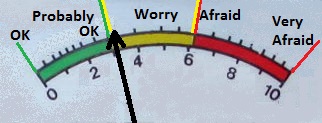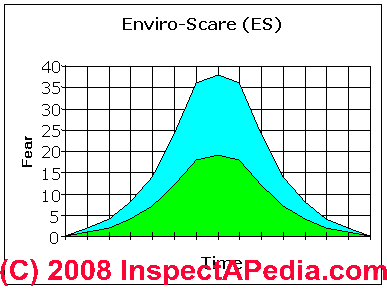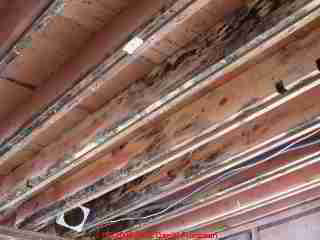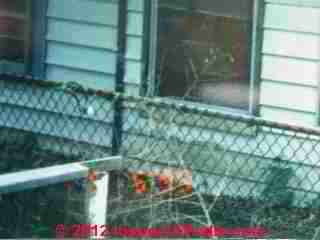 The Fear-o-Meter
The Fear-o-Meter
Building inspections & tests enable risk assessment & action plan
- POST a QUESTION or COMMENT about building damage or hazard risk assessment & the process of deciding when further investigation, action, or conclusions are warranted
Levels of severity or "fear" associated with inspetion observations can help determine what to do next.
Building damage or hazard general risk assessment helps decide on actions to be taken: this fear-o-meter article describes how a building inspector or forensic investigator collects evidence that then cross thresholds of reporting or action.
This "worry-threshold" approach explains how the the investigator must report or act appropriately to her or his overall assessment of the level of risk.
We include a discussion of the Fear-o-meter (the varying level of worry about the implications of clues observed at a building.
Dan's 3-Ds, describes how to set priority of repairs at a building.
We discuss how to determine & report the probability of a costly or expensive building or building environmental problem.
InspectAPedia tolerates no conflicts of interest. We have no relationship with advertisers, products, or services discussed at this website.
The Fear-o-Meter: Using a Promotion Theory of Observations To Detect, Investigate Further, or Report Building Defects & Hazards
 What is the Building Inspection Thought Process?
What is the Building Inspection Thought Process?
Our graph at left, discussed at ENVIRO-SCARE - PUBLIC FEAR CYCLES, illustrates that while some fears about high costs or unsafe conditions in or around buildings are more real than others, in general public anxiety about all of these topics varies over time.
Definition of Type I Errors & Type II Errors for Building Investigations
The purpose of describing a procedure for translating forensic or building observations into action thresholds is to improve the accuracy of the investigator's conclusions while at once avoiding unnecessary costs of either Type I Error mistakes or Type II Error mistakes.
- In building inspections a Type I Error (rejecting a true hypothesis) may be defined as failing to detect or recognize that a serious and actionable problem exists in the building or its systems.
- A Type II Error (accepting a false hypothesis) may occur if people believe that something is costly or dangerous when it is not.
An example of a Type II Error in which the property owner was incensed that the patterns on his garage ceiling were not in fact toxic black mold is discussed at BASKETBALL MOLD SYNDROME - BBMS.
Steps in a Building Investigation
The following steps describe what most competent inspectors actually do in the course of examining a building for evidence of these costly or dangerous defects. The inspector takes these steps, roughly in this order:
1. make observations
2. consider implications
3. evaluate interactions among components and systems
4. weigh risks and probabilities of a potential defect - levels of fear
5. collect more data which increases or decreases level of concern (fear)
6. continue until the observations (fear) force the defect across thresholds of reporting
7. make recommendations
 Four Point Fear-O-Meter: Simplified Building Defect or Hazard Reporting Thresholds
Four Point Fear-O-Meter: Simplified Building Defect or Hazard Reporting Thresholds
As thresholds of reporting or action are crossed, the inspector musty report or act appropriately to her or his overall assessment of the level of risk.
We pose first a simple four-point fearometer scale, followed for those who prefer, a ten-point fearometer scale.
1. Lowest worry: consider but do not report - premature, keep the observation in mind and continue inspecting
2. Medium fear: report potential defects to client with advice: watch, investigate
3. High fear: report likely defects to client and advise further action
4. Extreme fear: report or find and identify virtually certain costly or dangerous conditions
A 10-point Fear-O-Meter Scale
 Think in terms of an escalating measure of risk, or a "fear-o-meter" whose needle is moved towards the right - the red "great fear" zone by some observations or towards the left or green or less worrisome "low risk" zone by a series of observations or bits of information obtained during a building inspection.
Think in terms of an escalating measure of risk, or a "fear-o-meter" whose needle is moved towards the right - the red "great fear" zone by some observations or towards the left or green or less worrisome "low risk" zone by a series of observations or bits of information obtained during a building inspection.
Our photo (left) shows "black mold" that can be quite scary to lots of people. But in some cases what's thought to be harmful "toxic black mold" may only be a harmless, cosmetic growth on lumber - a discovery that means that with additional expert assistance a fearometer may swing back down from a high reading to a low one.
See details
at BLACK MOLD, TOXIC & ALLERGENIC and
What's the fear? It's that we fail to detect a condition that, when discovered, will be expensive to correct, or we fail to detect a condition at a building that is an immediate threat to life and safety (risk of collapse, improper use of chemicals) - in this case confined to the topic of insect damage.
(Obviously other building-related safety topics must not be ignored during any building inspection.)
As you collect visual data and interpret it along with historical data (repair history, leak history, age of property, history of modifications) about the site and building along with environmental data about the area (zone of high or low insect risks) your fear-o-meter pointer moves back and forth, crossing action thresholds.
- Fear-o-Meter readings above zero to 3 = areas of above-normal risk are observed; look further and with increasing care
- Fear-o-Meter readings 3-5 = A hidden problem is likely, further investigation is needed
- Fear-o-Meter readings 5-8 = A serious hidden problem is highly likely such that the time, cost, and trouble of invasive methods are justified. Even still any steps that the inspector can anticipate are likely to cause cosmetic damage should not begin before permission is obtained.
 Other events can disclose hidden damage under normal use and passage (walking on a surface, touching it with a finger or pencil or pen, operating a control intended for homeowner use, flipping a switch, opening an access cover or panel.
Other events can disclose hidden damage under normal use and passage (walking on a surface, touching it with a finger or pencil or pen, operating a control intended for homeowner use, flipping a switch, opening an access cover or panel.
Those are normal activities that, even if they then result in damage (finger goes through the side of a joist, walking on a roof and falling through rotted roof sheathing), those are not types of damage for which the inspector should be held liable. That is, she's not to blame for their revelation.
- Fear-o-Meter readings 9-10 = dangerous or costly damage has been confirmed or is virtually certain.
As we describe at CONTEXTUAL CLUES Can Expose "Hidden" Defects, Sometimes we can peg the Fear-o-Meter at 10 even without invasive methods.
Example:
Inspecting an aluminum sided building built on unknown foundation materials as its floor appears to be slab on grade, with no access beneath the building, and with exterior siding that extends below ground level, and observing buckled, bulged siding at the bottom of the wall almost certainly means that the building sills and possibly its lower wood framed walls have been structurally damaged by rot or insects or both.
Failure of an expert to issue a warning when that contextual clue is visible would be negligent. A building expert is expected to be capable of recognizing the significance of crushed buckled siding at ground over an inaccessible crawl space.
Contextual Clues Can Expose "Hidden" Defects
 Contextual clues, subtle little defects, visual or other anomalies, modifications, historical data, and site conditions may later suggest the presence of a costly or dangerous problem at probability high enough to justify a warning to the
client even when there is no unequivocal, directly visible defect.
Contextual clues, subtle little defects, visual or other anomalies, modifications, historical data, and site conditions may later suggest the presence of a costly or dangerous problem at probability high enough to justify a warning to the
client even when there is no unequivocal, directly visible defect.
(Example: very rusty old furnace in basement showing history of recurrent flooding, high risk of failed heat exchanger. Dangerous. Investigate further, reserve funds to replace unit.)
There is considerable argument among building inspectors about whether or not the inspector is obligated to report important building defects that are recognized by inference rather than by obvious simple visual data.
We inspected a house (shown at above left) with no accessible crawl space, a history of roof spillage around the foundation, trees close to the house, aluminum siding and framing below grade, and a bulged first course of aluminum siding all around the home.
Anyone familiar with how aluminum siding is placed on a building knows that you start from the first or bottom course and hang siding up the wall.
There is no way you could install a bulged first course. The bulge had to happen later - in this case from building settlement on crushing, rotted, or insect- damaged wood sills and floor framing. Yet outside there was no visible evidence of rot or insect damage to the house sills, since they were not visible (without invasive measures not part of a normal home inspection.).
The FEAR-O-METER pegged at 10.
The realtors present at this case study, and some of the building inspectors all argued that since one could not personally see a framing problem, there was nothing that should be reported. This camp argued that reporting a costly building damage condition was mere speculation.
I agree - that it is speculation, but I'd call it "informed" speculation. If the collection of contextual clues crosses a sufficient threshold of risk, such items should be reported. And of course, as most readers will suspect, later removal of siding showed very extensive sill and floor joist framing damage from termites and rot.
At $100./linear foot just for sill repairs, this was a very costly problem that needed to be brought to the attention of the building buyer and owner.
Weighing the Risks in Deciding What To Report
Weigh the risk of angry realtor who feels that you should not be thinking so carefully about hard-to-see defects, or embarrassment of being mistaken by warning of a potential hazard against the risk of someone's injury or in the case of collapsing septic and cesspool systems, dangerous chimneys and flues, carbon monoxide and combustion air problems (can't see that one can you?), or even mundane falling hazards, there is risk of serious injury or even death!
How to Set Priorities for Building Repairs: - Dan's 3-D's
How do we cope with the quantity of details which present themselves? Focus attention on the high-risk topics.
When is the Building In Control of the Expenditure of the Client's Money?
Here are the classes of findings which deserve highest priority of attention.
This little list can help the inspector and the inspector's client sort through the large volume of clues and "findings" that will be produced by any careful inspection of a building. For the following three items, the "building is in control of the client's money" in the sense that items in all three categories really need to be addressed promptly.
1. First Fix Things that are Dangerous
Examples: unsafe steps and rails, missing smoke and CO detectors, electrical or heating equipment that's not properly installed, unsanitary plumbing, backing up sewage, unsanitary well water, structure that's so damaged or improper as to risk collapse, leaning, collapsing chimneys, open septic tanks or cesspools, active sinkholes.
At SAFETY HAZARDS GUIDE we list common hazards - perhaps a scan through the list will help you recognize things in your own home that need attention.
Also see the longer hazards list at HOME INSPECTION SAFETY HAZARDS we describe hazards encountered when examining a building, but that's not just for inspectors it's for owners and occupants too.
2. Next Fix Things causing rapid, costly Damage
Examples: significant roof leaks (other than a trivial drip that's not wetting anything you can't catch temporarily in a single pan), buckling moving foundations, extensive active termite or carpenter ant damage to the structure,
At BUILDING DAMAGE ASSESSMENT & REPAIR we list high- priority recommendations for buildings that have been damaged by an event like an earthquake, fire or flood.
3. Next Fix Things that are essential & that Don't Work
Examples: Heating or air conditioning that does not work reliably, functional plumbing drainage, functional drinking water supply, safe chimneys and vents, missing electrical power for essential systems like A/C, heat, pumps, lighting, appliances.
At HOUSE PARTS, DEFINITIONS names house parts and link to articles about inspecting and fixing them but you can probably skip that page for now.
Go through all of the inspections and reports you have on your home, add in things you've observed that inspectors missed or under-reported, then sort them to pick out items in my 3 groups, then set to work on the dangerous items first.
Maintain this focus. Distinguish between what is potentially important (costly, dangerous, doesn't work) and what is not only unimportant (on a cost and risk scale), but can be a dangerous distraction.
Don't waste energy, and if you're an inspector, don't mislead your client by permitting the client to think that the purpose of your inspection was to find all possible building defects.
When is the Client or Building Owner in Control of the Expenditure of the Their Money?
Correcting other defects may be highly desirable, may make a building more economical to operate, or more comfortable, but they may be elective in that the client can decide when these expenses are to be incurred.
If a building has no insulation, the inspection and report need to point that defect out, and significant cost may be involved in its remedy.
But delaying the installation of insulation means higher heating or cooling costs, not that the building is suddenly unsafe or deteriorating rapidly (excluding the freezing pipe problem in freezing climates). So this is an example of an item which, while important, can be deferred.
You may point out minor defects, as a courtesy or even as an added service, but keep yourself and your client focused on the purpose of the inspection: to reduce the chances of a costly or very dangerous surprise. Otherwise both you and your client will be very sorry later. Explain this focus to your client.
Isn't this what you're already doing? Then why talk about it?
Supporting Research on Fear vs Risk
- Hart, Dennis L., Mark W. Werneke, Steven Z. George, James W. Matheson, Ying-Chih Wang, Karon F. Cook, Jerome E. Mioduski, and Seung W. Choi. "Screening for elevated levels of fear-avoidance beliefs regarding work or physical activities in people receiving outpatient therapy." Physical therapy 89, no. 8 (2009): 770-785.
- Heath, Linda, and Kevin Gilbert. "Mass media and fear of crime." American Behavioral Scientist 39, no. 4 (1996): 379-386.
- Heath, Linda. "Impact of newspaper crime reports on fear of crime: Multimethodological investigation." Journal of Personality and social Psychology 47, no. 2 (1984): 263.
- Li, Fuzhong, K. John Fisher, Peter Harmer, Edward McAuley, and Nicole L. Wilson. "Fear of falling in elderly persons: association with falls, functional ability, and quality of life." The Journals of Gerontology Series B: Psychological Sciences and Social Sciences 58, no. 5 (2003): P283-P290.
- Maren, Stephen, and Chun-hui Chang. "Recent fear is resistant to extinction." Proceedings of the National Academy of Sciences 103, no. 47 (2006): 18020-18025.
- Ollendick, Thomas H., and Neville J. King. "Origins of childhood fears: An evaluation of Rachman's theory of fear acquisition." Behaviour Research and Therapy 29, no. 2 (1991): 117-123.
- Pierce, Kent A., and Dwight R. Kirkpatrick. "Do men lie on fear surveys?." Behaviour research and therapy 30, no. 4 (1992): 415-418.
- Rachman, S., and C. Lopatka. "Return of fear: Underlearning and overlearning." Behaviour research and therapy 26, no. 2 (1988): 99-104.
- Ross, Catherine E., and Sung Joon Jang. "Neighborhood disorder, fear, and mistrust: The buffering role of social ties with neighbors." American journal of community psychology 28, no. 4 (2000): 401-420.
- Skogan, Wesley G. "The impact of victimization on fear." Crime & Delinquency 33, no. 1 (1987): 135-154.
- Sutton, Robbie M., and Stephen Farrall. "Gender, Socially Desirable Responding and the Fear of Crime Are Women Really More Anxious about Crime?." British Journal of Criminology 45, no. 2 (2005): 212-224.
- Zimmermann, Barbara, Petter Wabakken, and Michael Dötterer. "Human-carnivore interactions in Norway: How does the re-appearance of large carnivores affect people’s attitudes and levels of fear." Forest Snow and Landscape Research 76, no. 1 (2001): 1-17.
...
Continue reading at HAZARD vs RISK or select a topic from closely-related articles below, or see our complete INDEX to RELATED ARTICLES.
Or see these
Recommended Articles
- ADVANCED INSPECTION METHODS
- BASKETBALL MOLD SYNDROME - BBMS
- BLACK MOLD, HARMLESS
- BLACK MOLD, TOXIC & ALLERGENIC
- BUILDING DEFECTS LISTS
- BURIED OIL TANKS, FINDING
- DEFECT CLUSTERS
- ENVIRO-SCARE - PUBLIC FEAR CYCLES
- FEAR-O-METER
- FORENSIC INVESTIGATION of BUILDINGS
- HAZARD vs RISK
- TERMITE DAMAGE PROBING
- VISUAL PERCEPTION ERRORS
- WTC DUST PARTICLE - MICRO PHOTOGRAPHS
Suggested citation for this web page
FEAR-O-METER at InspectApedia.com - online encyclopedia of building & environmental inspection, testing, diagnosis, repair, & problem prevention advice.
Or see this
INDEX to RELATED ARTICLES: ARTICLE INDEX to BUILDING SAFETY
Or use the SEARCH BOX found below to Ask a Question or Search InspectApedia
Ask a Question or Search InspectApedia
Try the search box just below, or if you prefer, post a question or comment in the Comments box below and we will respond promptly.
Search the InspectApedia website
Note: appearance of your Comment below may be delayed: if your comment contains an image, photograph, web link, or text that looks to the software as if it might be a web link, your posting will appear after it has been approved by a moderator. Apologies for the delay.
Only one image can be added per comment but you can post as many comments, and therefore images, as you like.
You will not receive a notification when a response to your question has been posted.
Please bookmark this page to make it easy for you to check back for our response.
Our Comment Box is provided by Countable Web Productions countable.ca
Citations & References
In addition to any citations in the article above, a full list is available on request.
- In addition to citations & references found in this article, see the research citations given at the end of the related articles found at our suggested
CONTINUE READING or RECOMMENDED ARTICLES.
- Carson, Dunlop & Associates Ltd., 120 Carlton Street Suite 407, Toronto ON M5A 4K2. Tel: (416) 964-9415 1-800-268-7070 Email: info@carsondunlop.com. Alan Carson is a past president of ASHI, the American Society of Home Inspectors.
Thanks to Alan Carson and Bob Dunlop, for permission for InspectAPedia to use text excerpts from The HOME REFERENCE BOOK - the Encyclopedia of Homes and to use illustrations from The ILLUSTRATED HOME .
Carson Dunlop Associates provides extensive home inspection education and report writing material. In gratitude we provide links to tsome Carson Dunlop Associates products and services.

